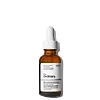What's inside
What's inside
 Key Ingredients
Key Ingredients

 Benefits
Benefits

 Concerns
Concerns

No concerns
 Ingredients Side-by-side
Ingredients Side-by-side

Water
Skin ConditioningNiacinamide
SmoothingPropanediol
SolventGlycerin
HumectantRice Ferment Filtrate
Skin ConditioningKojic Acid
AntioxidantSucrose
HumectantSqualane
EmollientSaccharomyces/Xylinum/Black Tea Ferment
Skin ConditioningPanthenol
Skin ConditioningZinc Gluconate
Skin ConditioningHydrolyzed Jojoba Esters
Skin ConditioningDisodium EDTA
Carbomer
Emulsion StabilisingZea Mays Oil
EmulsifyingLauryl Glucoside
CleansingXanthan Gum
EmulsifyingPhenoxyethanol
PreservativeEthylhexylglycerin
Skin ConditioningSodium Dehydroacetate
PreservativeTocopherol
AntioxidantWater, Niacinamide, Propanediol, Glycerin, Rice Ferment Filtrate, Kojic Acid, Sucrose, Squalane, Saccharomyces/Xylinum/Black Tea Ferment, Panthenol, Zinc Gluconate, Hydrolyzed Jojoba Esters, Disodium EDTA, Carbomer, Zea Mays Oil, Lauryl Glucoside, Xanthan Gum, Phenoxyethanol, Ethylhexylglycerin, Sodium Dehydroacetate, Tocopherol
Water
Skin ConditioningLactococcus Ferment Lysate
Skin ConditioningPropanediol
SolventPotassium Azeloyl Diglycinate
Skin ConditioningCarnitine
CleansingAcetyl Glucosamine
Skin ConditioningSarcosine
Skin ConditioningEctoin
Skin ConditioningAdenosine
Skin ConditioningPolylysine
Silanetriol
Glycerin
HumectantPentylene Glycol
Skin ConditioningSclerotium Gum
Emulsion StabilisingXanthan Gum
EmulsifyingIsoceteth-20
EmulsifyingCitric Acid
BufferingSodium Citrate
BufferingTrisodium Ethylenediamine Disuccinate
Sodium Chloride
MaskingEthylhexylglycerin
Skin ConditioningSodium Benzoate
MaskingPhenoxyethanol
PreservativeChlorphenesin
AntimicrobialWater, Lactococcus Ferment Lysate, Propanediol, Potassium Azeloyl Diglycinate, Carnitine, Acetyl Glucosamine, Sarcosine, Ectoin, Adenosine, Polylysine, Silanetriol, Glycerin, Pentylene Glycol, Sclerotium Gum, Xanthan Gum, Isoceteth-20, Citric Acid, Sodium Citrate, Trisodium Ethylenediamine Disuccinate, Sodium Chloride, Ethylhexylglycerin, Sodium Benzoate, Phenoxyethanol, Chlorphenesin
 Reviews
Reviews

Ingredients Explained
These ingredients are found in both products.
Ingredients higher up in an ingredient list are typically present in a larger amount.
Ethylhexylglycerin (we can't pronounce this either) is commonly used as a preservative and skin softener. It is derived from glyceryl.
You might see Ethylhexylglycerin often paired with other preservatives such as phenoxyethanol. Ethylhexylglycerin has been found to increase the effectiveness of these other preservatives.
Glycerin is already naturally found in your skin. It helps moisturize and protect your skin.
A study from 2016 found glycerin to be more effective as a humectant than AHAs and hyaluronic acid.
As a humectant, it helps the skin stay hydrated by pulling moisture to your skin. The low molecular weight of glycerin allows it to pull moisture into the deeper layers of your skin.
Hydrated skin improves your skin barrier; Your skin barrier helps protect against irritants and bacteria.
Glycerin has also been found to have antimicrobial and antiviral properties. Due to these properties, glycerin is often used in wound and burn treatments.
In cosmetics, glycerin is usually derived from plants such as soybean or palm. However, it can also be sourced from animals, such as tallow or animal fat.
This ingredient is organic, colorless, odorless, and non-toxic.
Glycerin is the name for this ingredient in American English. British English uses Glycerol/Glycerine.
Learn more about GlycerinPhenoxyethanol is a preservative that has germicide, antimicrobial, and aromatic properties. Studies show that phenoxyethanol can prevent microbial growth. By itself, it has a scent that is similar to that of a rose.
It's often used in formulations along with Caprylyl Glycol to preserve the shelf life of products.
Propanediol is an all-star ingredient. It softens, hydrates, and smooths the skin.
It’s often used to:
Propanediol is not likely to cause sensitivity and considered safe to use. It is derived from corn or petroleum with a clear color and no scent.
Learn more about PropanediolWater. It's the most common cosmetic ingredient of all. You'll usually see it at the top of ingredient lists, meaning that it makes up the largest part of the product.
So why is it so popular? Water most often acts as a solvent - this means that it helps dissolve other ingredients into the formulation.
You'll also recognize water as that liquid we all need to stay alive. If you see this, drink a glass of water. Stay hydrated!
Learn more about WaterXanthan gum is used as a stabilizer and thickener within cosmetic products. It helps give products a sticky, thick feeling - preventing them from being too runny.
On the technical side of things, xanthan gum is a polysaccharide - a combination consisting of multiple sugar molecules bonded together.
Xanthan gum is a pretty common and great ingredient. It is a natural, non-toxic, non-irritating ingredient that is also commonly used in food products.
Learn more about Xanthan Gum